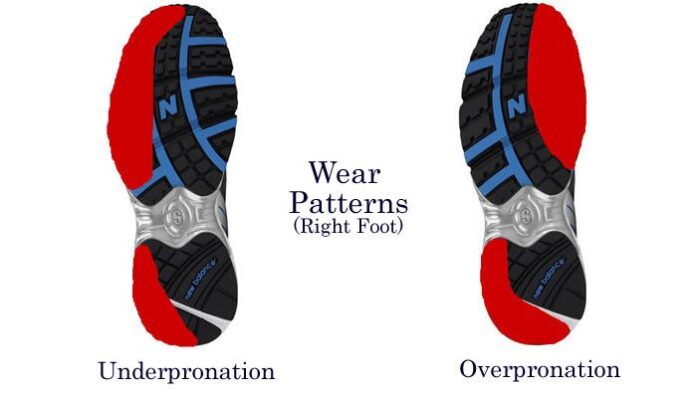Underpronation is a condition in which feet roll inward. Buy the best shoes for underpronation from us. Whatever your budget, our range of shoes are sure to meet it. Our customer service staff are always happy to talk to you and guide you.
What is Underpronation?
Underpronation is the opposite of overpronation. It is a condition where the foot rolls inward excessively. The foot is said to underpronate when it rolls inward more than normal and flattens out, but does not roll so far inward as in pronation. Underpronated feet have high arches and are often described as “flat feet.” However, this description isn’t accurate because most people with flat feet don’t have high arches.
People with underpronation tend to wear shoes that are too soft or flexible. They also need more arch support than other people who overpronate because they want their shoes to provide support for their flat feet. Underpronation can be a problem if you have low arches in your feet because it can lead to chronic ankle sprains and pain in the soles of your feet.
How is it caused?
Underpronation is caused by a biomechanical problem in the foot. The foot rolls inward excessively when walking or running, which can cause injuries to the feet and knees. Underpronation occurs when the foot is not stabilized properly as it strikes the ground during walking or running. The ankle joint is not strong enough to prevent the foot from rolling too far inward. The main symptom of underpronation is pain in the arch of your foot that worsens with walking or running.
You may also notice pain in your knees, hips and back if you overpronate due to instability in your lower extremities. In addition to pain and discomfort, underpronation can lead to other problems such as shin splints, plantar fasciitis and Achilles tendonitis. However, underpronation is not always a bad thing. It’s often beneficial for runners who have weak ankles because it provides more stability than overpronation does and helps absorb impact while running on hard surfaces
How is it treated?
Treating your underpronation should be done with a combination of supportive cushions and motion control shoes. Wearing well fitted shoes for underpronation womens can help to prevent your foot from rolling inwards in certain situations, but you also need to remember that the foot may still roll inwards during wear due to other factors including walking surfaces or running paces.
Benefits of Underpronation Shoe Wear
There are many benefits to wearing shoes with built-in orthotics if you have underpronation. You’ll reduce the risk of injury by supporting your arches and preventing them from collapsing during movement. You’ll also reduce the risk of ankle sprains by strengthening your ankles so that they can handle more impact while running or walking on uneven surfaces without giving out on you unexpectedly (which can cause sprains). Following are the additional benefits of wearing underpronation shoe wear:
Improved comfort: If you’re a runner who has fallen into the pattern of overpronation, underpronation shoe wear designed to correct this problem is probably what you need. Overpronation occurs when your feet roll inward excessively when you run. This can lead to injuries such as an ankle sprain or shin splints. The goal of running shoes for underpronation mens is to provide comfort and stability so that your foot doesn’t roll too far inward.

Shoes with a higher heel-to-toe drop will help keep your foot in place and support it throughout the stride cycle. Some types of walking shoes for underpronation are built specifically for those who overpronate. These shoes have features like extra cushioning and support that help keep the foot in place during each step. They also typically have a wider toe box and higher arch support than other types of running shoes.
Increased stability and shock absorption: An underpronator walks on the outside edge of their feet, causing the foot to roll outwards when walking or running. This motion puts more pressure on the outside of the foot, which can cause pain in the knees and ankles. Running shoes for underpronation womens provide increased stability and shock absorption. They also feature a higher heel-to-toe drop to help keep your foot from rolling outwards as you walk or run. A more flexible shoe with good arch support also helps reduce pronation by allowing for natural movement without restricting it.
Enhanced gait: Overpronators have a high arch and their feet tend to roll outward. In both cases, the foot is unstable and can cause problems with knee, ankle and back pain. Underpronation can also lead to shin splints. The solution is to wear shoes designed for underpronation that provide enhanced gait stability. These shoes will keep your foot from rolling inward as much as possible while still providing comfort and support during walking or running activities.
Takeaway: Shoes for underpronation are very beneficial
Shoes for underpronation are very beneficial as they help in reducing the stress on the knees and ankles. If you have a shoe that is designed for underpronation, then you should wear it when you walk or run. These shoes will help you in reducing the strain on your joints, which means that you will not suffer from any pain. If you want to buy shoes for underpronation, then make sure that they are comfortable enough to wear all day long.
You should also try them out before buying them so that they fit well and do not cause any issues with your feet or ankles. If you have been wearing shoes that are not made for underpronation, then it is time to switch over to shoes that are designed specifically for this condition. If possible, get a pair of shoes that can be worn everyday without causing any problems with your feet or ankles.
